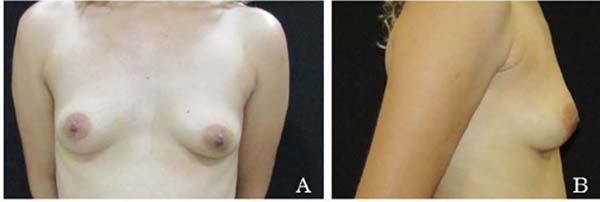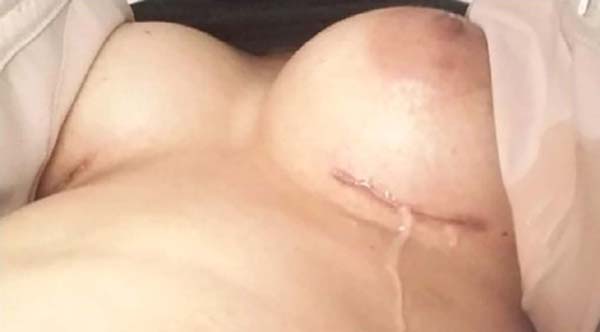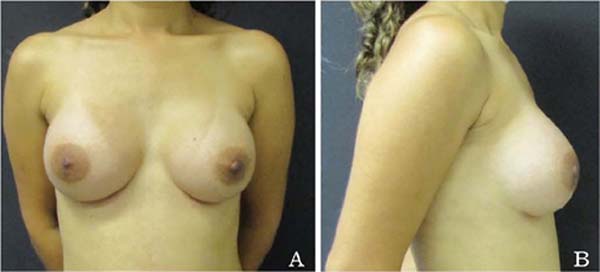INTRODUCTION
Augmentation mammoplasty using implants is a procedure performed with high frequency
worldwide. In 2020 alone, 1,624,281 surgeries were performed, according to the International
Society of Aesthetic Plastic Surgery (ISAPS)1. Although very safe, it is not free from complications. Some of these complications
are well known, such as hematoma, seroma, capsular contracture, infection, unsightly
scarring, and poor positioning of implants, and some are uncommon, such as galactorrhea2,3.
Galactorrhea and galactocele can occur in up to 0.96% of patients undergoing breast
augmentation with implants. On average, they take 15-90 days to manifest. Galactocele
was defined as the accumulation of milk in the surgical pocket, and this content can
be drained spontaneously through the surgical wound4. Galactorrhea is defined as the spontaneous excretion of milk by the papilla without
sucking stimulus3.
The cause of postoperative galactorrhea and galactocele has not yet been fully elucidated.
It is believed that the trigger may be due to the increase in prolactin due to surgical
stimulation or nerve compression of the rib cage. Some theories point out that the
mechanical compression of the implants on the gland or even the effect of other medications
taken by the patient may be responsible for such intercurrence5.
Treatment is based on prolactin inhibitors such as bromocriptine4,6,7 and may be associated with percutaneous or open surgical drainage of the galactocele7. Because it is a rare intercurrence that the surgeon may face one day, we present
a case experienced in our service, as well as the treatment scheme used and the postoperative
follow-up with 10 months of surgery.
OBJECTIVE
To present a case of galactocele in a patient who underwent breast augmentation with
implants, to report on the management of the case, applied treatment, and results.
CASE REPORT
We report the case of a 35-year-old female patient, complaining of hypoplastic breasts
and desire for breast augmentation (Figures 1A and 1B), admitted to Hospital Irmãos Penteado, Dr. Ricardo Barouldi, in Campinas, S P. She
had two previous pregnancies and had stopped breastfeeding one year after the surgery.
The patient tended to form a keloid scar without other important antecedents. In October
09, 2020 a breast augmentation surgery was performed using 300ml textured implants
in the subglandular plane and via an access route in the inframammary fold. The postoperative
period was uneventful, and the patient evolved adequately.
Figure 1A - Preoperative patient (front view). Figure 1B. Preoperative patient (lateral view).
Figure 1A - Preoperative patient (front view). Figure 1B. Preoperative patient (lateral view).
Thirty days after the surgical procedure, a milky secretion (Figure 2) drains spontaneously through the surgical wound without pain, fever, or other symptoms,
in addition to bilateral galactorrhea. Cabergoline 0.5mg every 12 hours was used,
associated with cefadroxil 500mg every 12 hours for 48 hours. This regimen of cabergoline
pulses was repeated 45 days after the surgical procedure. With this approach, the
patient presented a progressive decrease in secretion drained by the surgical wound,
completely ceasing 60 days after the surgery.
Figure 2 - Spontaneous drainage from the surgical wound of milky secretion.
Figure 2 - Spontaneous drainage from the surgical wound of milky secretion.
The patient evolved with a hypertrophic scar in the region of the inframammary fold,
which was treated with four sessions of intra-cicatricial infiltration of triamcinolone
acetate. Six months after the operation (Figures 3A and 3B), the breasts are symmetrical, without signs of contracture or additional alterations;
the patient is satisfied with the result and without new episodes of galactorrhea
or galactocele.
Figure 3A - Six-month postoperative period (frontal view). Figure 3B. Six-month postoperative
period (lateral view).
Figure 3A - Six-month postoperative period (frontal view). Figure 3B. Six-month postoperative
period (lateral view).
DISCUSSION
Galactorrhea is a rare complication that occurs in breast augmentation surgeries.
It was first described in 1971 as the spontaneous release of milk not associated with
breastfeeding6,7. Initially, it can be confused with infection or breast abscess due to edema, pain,
and the appearance of secretion8. Among the causes of galactorrhea, we can highlight nipple stimulation, pregnancy,
use of medications that increase prolactin production, iatrogenic hyperprolactinemia
above 27ng/ml, thyroid alterations, renal alterations, and prolactinomas9.
Among the causes of postoperative galactorrhea after breast augmentation, it has been
suggested that there is an increase in prolactin in response to lactotrophic cells
in the anterior pituitary, which leads to milk production; prolactin can increase
up to 5 times due to the surgical stimulus9. Another theory indicates that the surgery’s irritation of the costal nerves leads
to a suppression of the hypothalamic axis, with a decrease in the release of dopamine4. However, the systematic review published by Sharma & Basu4 found that not all patients
had high levels of prolactin in the postoperative period.
We can point out some risk factors associated with galactorrhea, such as the last
pregnancy close to the surgery period, greater number of pregnancies, previous lactation,
and use of contraceptive medication.
Regarding the implant insertion plane, those allocated in a subglandular position
and periareolar incision are more related to galactorrhea4. According to Chun & Taghinia10, this is due to the obstruction of some galactophoric ducts in the breast. The onset
of symptoms is reported in an average of 15 days and may manifest after 90 days after
surgery3,6.
Some tests can be routinely used, such as measurement of serum levels of prolactin,
Beta-HCG, complete blood count, C-reactive protein, thyroid tests, and IV Sudan test
to determine milk6,7,11. Regarding imaging tests, ultrasonography, secretion cultures, and pituitary magnetic
resonance in case of hyperprolactinemia above 100ng/ml4 may be necessary for diagnostic
confirmation.
After confirmation of the condition, we must proceed with drug treatment. Authors
propose different approaches, including using bromocriptine at a dose of 2.5mg twice
daily as the first line and cabergoline 0.5mg 1-2 tablets per week and as the second
line2,4,11. Antibiotic treatment may also be included due to the risk of infection associated
with the implant4,11, dopamine inhibitors, leukotriene inhibitors, to avoid the chance of capsular contracture6,
and explant with pocket washing4,6,11.
In the literature review, we found that most published studies are case reports similar
to this one: two case series and one systematic review.
We believe that expanding the number of studies on this topic will be important to
unify behaviors and minimize this intercurrence.
CONCLUSION
Galactorrhea and galactocele are rare complications of breast augmentation. With an
adequate diagnosis and early treatment, we managed to treat it without changing the
outcome of our surgeries. More investigations are needed regarding this rare intercurrence
to unify conducts and minimize complications.
1. Hospital Irmãos Penteado, Serviço de Cirurgia Plástica Dr Ricardo Barouldi, Campinas,
São Paulo, Brazil
Corresponding author: Raphaela Silveira do Amaral Av. José Bonifácio, 2001, Campinas, S P, Brazil. Zip code: 13092-305 E-mail: rapha_samaral@hotmail.com














